Chrysanthemum Chrysanthemum is a genus of perennial garden flowers of the Asteraceae family. They are native to Asia and Northeastern Europe. Most species come from East Asia, with the greatest variety in China, where chrysanthemums were grown there from the 5th century BC, came to Japan in the eighth century AD, and to England at the end of the 18th century.
Chrysanthemums are herbaceous plants with woody stems or subshrubs with erect stems, usually covered with fine pubescence (glabrous in some species). The leaves are alternate, entire or notched, with a jagged edge. The foliage color is green or light green. If you rub the leaves or break a branch, you will notice a peculiar smell, sometimes quite tart, a characteristic difference between chrysanthemums and asters.
Inflorescences are baskets of small flowers of two types: central tubular, yellow, marginal flowers - reed flowers of a wide variety of colors. The fruit of the chrysanthemum is an achene.
Classification of chrysanthemums
In the process of selection, simple inflorescences have almost completely replaced semi-double and double ones, in which the inflorescence has a cap of multi-row reed flowers. But in addition to double and simple inflorescences, there are other forms: anemone-shaped, tubular, Chinese, peony-shaped, pompom-shaped, decorative, arachnid, etc. Often the difference lies in the shape of the reed flowers - in some varieties they are straight, in others they are slightly curved like a boat, in others they are slightly spiral.
Most often, perennial frost-resistant chrysanthemums of Korean selection are used for garden landscaping, as they are the most unpretentious and frost-resistant; they are often popularly called 'oak' - due to the shape of the leaves, reminiscent of oak leaves.
All varieties of chrysanthemums can be divided according to flowering periods into:
- Early bloomers - bloom at the end of August. These varieties are usually low-growing and dense bushes about 25-35 cm tall, used in borders.
- Medium flowering - bloom in early September, mainly with an average height of bushes of 50-60 cm.
- Late flowering - bloom at the end of September, beginning of October, mostly tall, up to 100 cm or more, require garter.

Chrysanthemums bloom for more than a month. Low-growing varieties, as a rule, have very decorative foliage, which allows the formation of multi-tiered flower beds that bloom from late summer to late autumn.
Garden perennial chrysanthemum varieties photo
Among the variety of plants for organizing flower beds and flower beds, the so-called “classics of the genre” occupies a special place. Year after year, it invariably includes perennial garden chrysanthemums, which amaze even the most experienced gardener with the variety of their varietal colors, shapes and types. Chrysanthemums decorate our gardens with bright colors from July until late autumn, when most other plants have long finished flowering. Despite the rain, wind and cold, the mass of bright flowers with a cold, bitter aroma remains on the chrysanthemum bushes until late autumn. In this material you will learn about the varieties, planting and care of perennial garden chrysanthemums.

Chrysanthemum perennial description
The bush perennial chrysanthemum has earned enormous popularity and love among gardeners due to its attractive appearance, decorativeness and ease of care. Perennial small-flowered bush chrysanthemums grown in open ground are called ground or Korean. Chrysanthemum received another popular name “oak” due to the shape of its leaves, similar to oak leaves. The height of the Korean chrysanthemum bush can reach from 30 cm to 1.2 meters. The plant has a branched rhizome that produces root shoots; the root goes into the ground to a depth of 25 cm. There is an incredible variety of varieties and species, differing in color, shape and flowering period of the inflorescences.
The inflorescence of a flower is a basket consisting of many individual flowers. There can be up to 100 of them on one bush. The amazing variety of flower colors, their delicate pleasant aroma and ability to remain fresh for a long time after being cut attracts not only gardeners, but also florists who use chrysanthemums to create bouquets and bright autumn compositions.
The size of the inflorescences of garden perennial chrysanthemums
Perennial chrysanthemums are divided into three groups based on the diameter of their flowers: small-flowered; medium-flowered; grandiflora. Small-flowered or Korean plants can be simple or double. A large number of inflorescences with a flower diameter of 2-10 cm grow on one bush. The bushes themselves can reach a height of 25 to 120 cm. The leaves of the plant have the shape of oak leaves. Flowers are frost-resistant, undemanding to soil composition and easy to care for. Their flowering begins in mid-September and continues until frost. Medium-flowered or decorative chrysanthemums can be grown not only to decorate the garden, but also for cutting. They also grow well in pots at home. They can decorate balconies, loggias and terraces. Decorative bushes grow up to 30-70 cm, and have a flower diameter of 10-18 cm. Large-flowered chrysanthemums are spectacular tall plants. The length of their stem can reach from 80 to 120 cm. They bloom with large flowers with a diameter of 10-25 cm. This type of chrysanthemum does not tolerate frost well. Only certain varieties of it can winter in open ground. These flowers are mainly intended for cutting into bouquets.
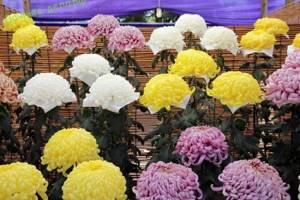
Propagation of garden perennial chrysanthemums
Bush chrysanthemum can be propagated in the following ways:
- cuttings;
- seeds;
- division of rhizomes;
- layering.
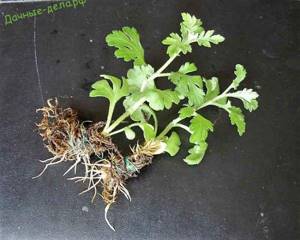
Varieties of border garden perennial chrysanthemums
These low-growing bush chrysanthemums occupy a special place in the list of the most beautiful garden flowers. Tiny flowers, despite their 30 cm height (or even less), independently form an ideal ball shape in their bushes, without requiring any additional adjustments. The best varieties: Talisman. The plant with its bright, even provocative flowers of raspberry-beet color will become the highlight of the garden plot. Evening lights. Dazzling flashes of piercing scarlet petals will create the feeling of a real holiday fireworks display. Varvara. It will add calmness and help slightly mute an overly bright flower bed with its inflorescences with a delicate, lilac-lilac tint.

Varieties of medium-sized garden perennial chrysanthemums
Medium-sized garden chrysanthemums, perennial varieties or hybrids of which have a height of 30-50 cm, will help bring any phytodesigner’s idea to life. Indeed, among the plants of this series you can find the entire rich range of colors of inflorescences. Flowers of this category look great in single-row clumps (large flower groups) and flower beds. The best varieties: Lelia. A spectacularly beautiful variety with rich dark crimson inflorescences will become a bright accent in any flower arrangement. Dune. Chrysanthemum-sorceress. Unobtrusive, muted yellow-brown flowers change color to golden yellow as they bloom. Zorka. One of the most beautiful varieties. Double inflorescences are yellow-brown with a copper tint. Such flowers create a slightly sad and romantic feeling of velvet autumn.
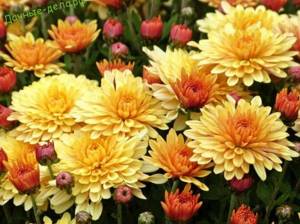
Varieties of large-flowered garden perennial chrysanthemums
Luxurious large chrysanthemums (flower diameter 10-25 cm, average height 80-120 cm) of different shapes of inflorescences, grown mainly for cutting. Most often, this type of chrysanthemum does not overwinter in open ground, but recently varieties have been developed that can be left in the garden for the winter:
- Anastasia Green – green needle-shaped chrysanthemums, bush 80-100 cm tall, blooms from October, overwinters in the ground, but requires shelter;
- chrysanthemum Zembla Lilac - very large double pink chrysanthemums, wide petals, bush height 90 cm, winters in the garden. The Zembla series potted forms are very popular;
- Tom Pierce - red chrysanthemum, the reverse side of the petal is orange, the shape of the flower is spherical, diameter - 22 cm, bush height - 150 cm, blooms from September.
Varieties of small-flowered garden perennial chrysanthemums
These include the Korean chrysanthemum, the planting and care of which is discussed in our material. The size of the flowers varies from 2 to 10 cm, the shape of the leaves resembles oak leaves, but much smaller in size. Flowering begins in early autumn and can continue until frost. Popular varieties of chrysanthemums in the Moscow region: Cheburashka, Talisman, Multiflora.
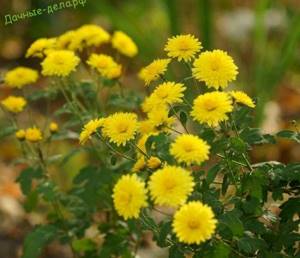
Planting and caring for garden perennial chrysanthemums
Chrysanthemums are grown in previously prepared and fertilized soil. Plants are planted from greenhouses in early summer. The distance between plants is about 35 cm. A strong peg is placed near each bush - this will protect the stem of flowering chrysanthemums from breaking.
Growing to keep chrysanthemums beautiful requires following just 5 recommendations:
- Plant the plant in an area with good lighting. Shade from the midday heat.
- Drained, slightly acidic soils are optimal. Ordinary soil is also suitable - with the addition of sand and humus.
- In spring, flowers are watered abundantly. The degree of watering is gradually reduced from the moment the buds form and brought to a minimum level during flowering. The soil around the plant should not be damp - only damp.
- Mineral and organic fertilizing should be carried out regularly - once every 2 weeks.
- Plants need rest, regular division and shelter for the winter.
Garden perennial chrysanthemums in landscape design
The chrysanthemum looks charming and gentle surrounded by tall perennial plants: dahlia, bush aster, asparagus and other plants. Lush and bright chrysanthemums are an ideal decoration for any garden and area. With the participation of these plants, you can create luxurious flower beds and mixborders; with their help, clearings and lawns are decorated. Among the bright emerald greenery, the bush chrysanthemum forms expressive spots of orange, purple, and lilac color. Almost all varieties of bush chrysanthemum are suitable for spectacular landscape design.
Share link:
Place for planting garden chrysanthemums
Chrysanthemums grow best and produce the most flowers when planted in a sunny area. They need at least three hours of full sun per day.
They also require well-fertilized soil, enough moisture, but not too much. Chrysanthemums do not tolerate dry, peaty or sandy soil, which is poor in mineral composition and does not retain moisture. But they also cannot tolerate stagnation of water and dampness!
Ideally, they need light sandy loam soil, well seasoned with humus and organic matter. Like most garden flowers, chrysanthemums thrive in well-drained soil with plenty of organic matter, such as compost.
We do not recommend growing chrysanthemums in the same place for more than three years in a row to avoid associated diseases and pest problems.
Landing
The soil in flower beds for chrysanthemums needs to be prepared in advance: if it is heavy, clayey, add sand, humus, peat, you can measure it in buckets, take everything in equal parts. If the soil is light sandy, add loam, turf soil and humus. Peat soils require serious improvement - they are poor and acidic; loam or turf soil and humus must be added.
All components added to improve the soil must be mixed well. The fertile soil layer should be less than 40 cm.
If you have a plot in a lowland or on a slope, before filling the flower beds, add a layer of crushed stone drainage to the bottom of the trench.
Another important indicator of soil quality that you should pay attention to when planting chrysanthemums is acidity. Changes in acidity or alkalinity can seriously limit plant growth, weaken the root system and even lead to death. Chrysanthemums prefer an acidity of about 6.5, absolutely not lower than 6.2. To increase the pH of the soil, you need to lime the soil, and to lower it (on saline soil) add iron sulfate or aluminum sulfate.
For deoxidizing soil for chrysanthemums, dolomitic limestone is preferred because it contains magnesium and other minor amounts of nutrients. Slaked lime is not desirable - it very quickly reacts with a change in acidity and, when combined with mineral fertilizers, blocks available phosphorus.
We plant chrysanthemums obtained from dividing an old bush, container chrysanthemums purchased at a nursery, or rooted cuttings in rows depending on the size of the bushes: at a distance of 20-30 cm from each other for low-growing and medium-growing varieties, 45-50 cm for large-growing varieties.
Caring for chrysanthemums
Caring for chrysanthemums involves regular watering, fertilizing, removing faded inflorescences, trimming excess branches and plucking out buds. It is necessary to rejuvenate old bushes in a timely manner - once every three years.
How to water chrysanthemums
At the beginning of the growing season, chrysanthemums are watered about once a week, generously wetting the top layers of soil. In summer, as the temperature rises, the frequency of watering increases, this can be once or twice a week, depending on the weather. By the time of flowering in September, watering is even more frequent - at least three times a week, but do not forget that frequent watering is permissible only on well-drained soil!
Feeding
Chrysanthemums require a rich set of nutrients, in addition to nitrogen, phosphorus, potassium, sulfur, calcium and magnesium are needed in significant quantities, and small amounts of iron and manganese are also needed, less significant, but it is desirable to be included in fertilizers for chrysanthemums: boron, copper and zinc.
Nitrogen is an element that promotes rapid leaf growth, but is most useful only at the beginning of the growing season, before the formation of inflorescences. Do not use nitrogen fertilizers later than June! If this element is added in excess, especially with a lack of light, the plant forms weak stems and a sluggish root system, and very easily becomes ill with powdery mildew and other diseases.
Caring for garden chrysanthemums
Culture does not belong to the category of demanding or whimsical. For normal growth and flowering, it does not need much:
- timely watering;
- periodic feeding;
- regular loosening and weeding.
Plants should only be watered at the roots, otherwise spots will appear on the leaves and there will be a risk of the bushes becoming infected with fungal diseases. Water for irrigation should be settled for at least a day or rain. The frequency of watering is at least three times a week. In this case, the amount of water should be 2 liters per tall plant, 1-1.5 liters for medium-sized and low-growing ones. Immediately after watering, the soil must be loosened and cleared of weeds.
To reduce the amount of watering and curb the growth of weeds, flower beds can be mulched with wood chips or mowed and sun-dried green manure.
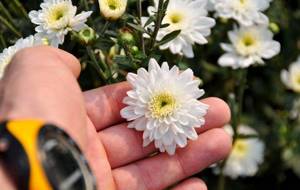
Chrysanthemums need to be fed at least once a month, alternating organic and mineral fertilizers:
- the first fertilizing is carried out 4-6 weeks after planting with ammonium nitrate;
- second feeding - 2-3 weeks after the first with infusion of weeds with the addition of nitrogen fertilizers;
- the third feeding is carried out 3-4 weeks after the previous one with phosphorus-potassium fertilizers with microelements;
- the fourth feeding is carried out after another 2-3 weeks with an infusion of herbs with the addition of potassium, phosphorus and bird droppings (in the form of fermented infusion);
- subsequent fertilizing is carried out with complex mineral fertilizer for garden flowers.
Important rule! It is better to underfeed plants with nutrients, especially nitrogen, than to overfeed them to the detriment of flowering and preparation for winter.
Chrysanthemum propagation
Chrysanthemums are propagated by seeds, cuttings and division; chrysanthemums in pots can be purchased at nurseries. Chrysanthemums are propagated by seeds very rarely - the grown plants do not retain varietal qualities, and you can get completely unexpected shapes, colors and sizes.
If you want faster flowering, you need to propagate by division. To do this in the spring, at the beginning of the season, when the plants begin to grow, use a shovel to separate part of the bush from the periphery of the mother plant and plant it in a prepared flowerbed, filled with organic matter and complex fertilizer.
Old chrysanthemum bushes can be divided into several parts, leaving only the rather depleted middle.
Cuttings can be taken from chrysanthemums of any age. When the stem grows approximately 15-17 cm, cut off the top 10-14 cm and tear off the lower part of the leaves. You can dip the tip of the cutting into the root, although this is not necessary. But you definitely need to sterilize the soil in the pot.
Options for soil mixture for cuttings:
- coarse river sand and universal peat soil (from the store) in equal parts
- coarse river sand and vermiculite in equal parts
- coarse river sand and sphagnum moss in equal parts
The soil needs to be sterilized in the oven or steamed in the garden over steam, and then shed with a solution of phytosporin. Immerse the cutting in it with the part where the leaves were removed. You can root cuttings in large peat tablets.
Keep the soil moderately moist, but not soggy. And be sure to keep it warm - for rooting you need a temperature of about 22-24°C and shade from direct sun.

You can cut chrysanthemums during the summer, just not in the hottest time. Roots form in about two weeks. When you see that the cutting has begun to grow new leaves, everything went well. After the young shoots have grown by about 5 cm, you can transplant young chrysanthemum bushes into flower beds using the transshipment method: without touching the root ball, remove them from the pot and plant them in prepared holes.
With any method of propagation, divisions or cuttings, if the weather is very sunny, need to be shaded for 2-3 days. At the same time, rooted cuttings and young bushes should not be buried in the soil in the flower bed to a depth greater than they were rooted in the pot or in the old place.

The first watering can be carried out with a solution of the zircon preparation.
After planting in a permanent place in the garden, the soil around the chrysanthemums must be mulched to prevent the roots from drying out and to create a barrier to weeds. In addition, mulch protects the root system from overheating in the heat, and from hypothermia in winter.
Gradually, the mulch breaks down and forms humic acids, improving the quality of the soil - it becomes loose or crumbly. If you do not mulch the soil, then when planting chrysanthemums purchased in containers from the nursery, sprinkle them with soil 1.5-2 cm higher than in the pot.
How to plant chrysanthemums in autumn
If you managed to purchase a chrysanthemum cutting or a container plant at the end of summer or autumn, you can plant them in flower beds until mid-September so that they have time not only to take root in a new place, but also to sufficiently increase the root mass. If you don't meet deadlines, store chrysanthemums in containers.
It is necessary to transplant the chrysanthemum from a store pot or glass where the cutting took root into a wide but low container with universal flower soil. Do not prune immediately, just place the container in a moderately cool room. If you have an insulated balcony, you can grow chrysanthemums there until the end of October.
You can trim the above-ground part when the temperature reaches about +4 °C. If sub-zero temperatures are not expected on your balcony, then you don’t need to do anything else, just periodically - once a month or less often - water the plants a little, just enough so that the soil does not dry out completely.
If your temperature can drop slightly below zero (the balcony is glazed, but not heated), prepare a large cardboard box and insulation material: sawdust, straw, dried sphagnum moss, or a large cotton blanket.
When it gets colder (below +3-4°C), place the container with the chrysanthemum in a box, fill the gaps between the walls with sawdust, or lay batting or foam rubber. Focus on the thermometer readings. If necessary, cover with a blanket, stop watering, the soil should be dry. Cold temperatures below -2°C are unacceptable. Those. the temperature on the balcony can drop below zero (down to minus 5-7°C), but in a pot with chrysanthemum it remains at least minus 2°C.
If you have a warm greenhouse in your garden, then in February-March you can move the flowers there, water as needed - the soil should not be constantly damp or dry out, only moderate moisture.
If there is a lot of planting material in the greenhouse, carry out preventive treatment against diseases - spray all plants with phytosporin or hang iodine cushions (moisten tea bags with 0.5 ml of iodine for each and hang in 2-3 places in the greenhouse). The problem is that chrysanthemums are prone to fungal diseases, and greenhouses are poorly ventilated. Iodine vapors help disinfect the air and keep plants healthy until they are planted in flower beds in early May.
Create a chrysanthemum paradise
- VK
- Youtube
Autumn is a time of year that enchants us with its fabulous splendor and richness of colors. Again and again she paints the trees and bushes in bright yellows, reds, oranges and golden browns, and wraps the harvested fields, nuts, acorns and shiny chestnuts in a velvet veil of all shades of brown. Nature, as it were, notifies us of the end of the gardening season and is preparing for winter peace. But not everything is over yet: autumn flowers, such as chrysanthemums, literally stun with their splendor and sophistication at this time of year. With their bright colors they make us forget about the coming winter, and create a calm, relaxing and at the same time full of life atmosphere in the garden. China and Japan are considered the birthplace of this “golden-colored” flower. The inhabitants of these countries knew chrysanthemums more than 2000 years ago. In China, the chrysanthemum represents fidelity, and in Japan its image is included in the national emblem and is a symbol of the sun. The colorful flower was brought to Europe in the mid-19th century. Since then, he has gone on a triumphal procession through gardens and parks around the world. No wonder, because the chrysanthemum was loved not only for its beauty, diversity, grace and tenderness, but also for its unpretentiousness, endurance and late flowering. Due to their increased durability when cut, florists are happy to include these flowers in their compositions. In terms of the variety of shapes and shades of inflorescences, chrysanthemums have no equal among autumn flowers. In addition to red, yellow, orange, pink, lilac, and white flowers, today there are also two-color and variegated chrysanthemums that create interesting accents in the flower garden.

Chrysanthemums in tubs
Due to the fact that chrysanthemum is ideal for pot culture, it is almost indispensable for decorating a balcony, terrace or staircase at the entrance to a house. Even in the garden, this shrub creates an extraordinary picture. Since most chrysanthemums are winter-hardy, you can plant them in the garden immediately after purchasing. These varieties include `Goldmarianne` with yellow semi-double flowers, and `Mei-Kyo` with purple-pink inflorescences.
Exquisite pink and purple pom pom chrysanthemum 'Mei Kyo'
Behind them, from mid-September, bright yellow chrysanthemums `Tante Heti`, `Fellbacher Wein` red and the lovely pink-yellow `Isabellrosa` continue to bloom. And in October, the chrysanthemums `Vrenli` and silver-pink `Nebelrose` bloom in copper-red color. They complete the round dance of flowering of this amazing flowering shrub. Interestingly, the `Ordensstern` variety boasts the longest flowering period: from August to November. Its double flowers shimmer with a golden-bronze hue. Only during flowering on frosty nights should cold-resistant chrysanthemums be covered with spruce branches or brushwood to protect them from the cold.
There are also varieties that are afraid of winter cold. It is better to immediately plant them in flower pots or tubs and move them to a cool room for the winter.
Sparkling silver pink, double chrysanthemum 'Nebelrose'
Happy partnership
Chrysanthemums get along very easily with many other plants. You can create interesting compositions for the balcony by combining plants with different autumn shades, or with a variety of structure and shape of foliage. Chrysanthemums in combination with ivy, cyclamen or heathers such as Erica gracilis and common heather (Calluna vulgaris) in interesting bowls and tubs are perfect for decorating an autumn terrace and apartment.
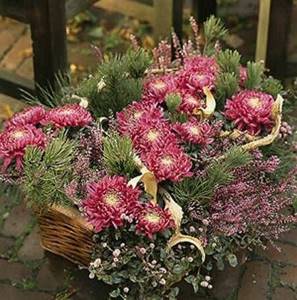
To decorate a garden in a rustic style, baskets with autumn chrysanthemums and heather are suitable. Pink and purple colors will add a touch of lightness and warmth to the composition.
A standard chrysanthemum in a large beautiful tub, at the foot of which there is room for ground cover plants, always attracts attention, both on the balcony and at the entrance to the house. Yellow or orange chrysanthemums in combination with pumpkins will remind you of the upcoming Halloween holiday. A composition of yellow chrysanthemums, cotoneaster horizontalis, seaside groundsel (Senecio cineraria) and Calocephalus brownii also looks elegant and original on a balcony or terrace. Against the background of silvery foliage of ragwort and calocephalus, the bright red color of cotoneaster berries and the yellow color of chrysanthemums become more saturated.

A piece of sun in a composition of chrysanthemums and paprika, creating a warm atmosphere on the terrace
Barbara Schmitt, Viticulture and Horticulture Specialist at the Bavarian State Office, offers an unusual partner for chrysanthemums: bright red and yellow paprika, which adds vibrant color to the autumn composition. Cheerful, playful partners of chrysanthemums are cereal grasses. New varieties of switchgrass, miscanthus, sedge and reed grass add lightness and airiness to the composition. Compact bushes of rosemary, catnip, astilbe, sedum, muhlenbeckia make up the court nobility for Queen Chrysanthemum.
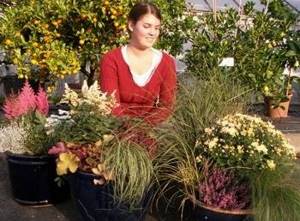
Gifts from Mother Nature's box
If you carefully walk through the autumn garden, you will definitely find interesting decorations for chrysanthemum compositions. Natural accessories will suit any bowl and any tub: rose hips, fruits of Physalis vulgare, decorative mini-pumpkins, spikelets will definitely add variety to the composition. By decorating tubs of chrysanthemums with nuts, chestnuts, berries, fir cones, beautifully colored leaves of various sizes and shapes, you will create a cozy autumn atmosphere.

Ideal location for chrysanthemums
Chrysanthemums prefer loose, permeable soils with a high content of nutrients. And they do well on sandy soil. The lighter the location of the chrysanthemums, the more magnificent they bloom. And in a place protected from the wind, the flowers will last a very long time.
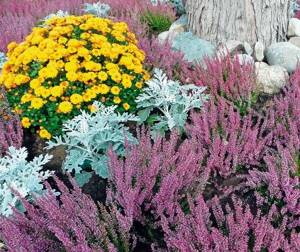
Chrysanthemums look nice surrounded by heather and moonflower.
Planting and care
It is best to plant chrysanthemums in the spring, then by autumn the bush has time to get stronger and reach a stable size. At low temperatures, the plant does not like stagnant water, so it is better to plant it in high flower beds. Chrysanthemums will thank you if you regularly feed them with fresh compost. In the first years, young plants are still weak, so they need to be tied to a support stick.
Preparing for winter
Winter-hardy chrysanthemums winter well in open ground, but also need protection from the cold. Plants should be covered with spruce branches and brushwood. There are different opinions as to whether it is worth pruning the above-ground parts of plants after the first autumn frosts or not. Scientists at the Horticulture Research Institute in Hannover Alem, Germany, have concluded that if faded shoots of chrysanthemums are not pruned in late autumn, new shoots will appear earlier in the spring and will be much stronger. Unpruned, faded shoots will provide additional protection from the cold. After winter, in spring, last year's stems can be cut off. When overwintering in a bright and fairly cool room, it is recommended to prune the chrysanthemum.
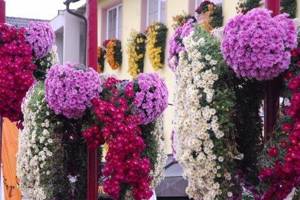
A riot of cascading chrysanthemums in the German city of Lahr
Translation: Lesya V. especially for the gardening internet portal
Publication date: October 18, 2010
comments
Lesya Vasko
If you notice an error, select the required text and press Ctrl+Enter to report it to the editors
Comments:
There are no comments yet, you can add your own comment. For this you need to register or log in.
Authorization
You have entered an incorrect login/password
adding a comment
Useful articles
- Polycarbonate greenhouse
Formation of a chrysanthemum bush
At the beginning of the season, when the stems grow in the spring, pinch them at a height of about 15-20 cm, approximately 2-3 cm from the crown. This will force the plant to actively branch, and when the side branches grow another 15 cm, pinch out the top 1.5-2 cm again. This pinching process must be completed 50-60 days before the expected flowering - early flowering ones can be pinched until July, mid and late flowering ones - Until August.

The sizes of inflorescences are different for different varieties, large-flowered chrysanthemums have a basket diameter from 10 to 25 cm, they are grown in 2-3 stems, pinch and leave the largest inflorescences at the ends of the shoots - these are most often offered as cut flowers for bouquets, usually 1 on one branch -5 inflorescences.
Small-flowered chrysanthemums have a basket diameter of 2-9 cm, are usually grown in bush form, and the inflorescences are not single baskets, but a complex shield or panicle, with 15 - 20 inflorescences on one branch.
Chrysanthemums in winter
At the end of autumn, when the foliage dies, cut off the entire above-ground part of the plants at a height of 15-20 cm from the ground.
The cold resistance of chrysanthemums varies among different varieties; some are very frost-resistant, and there are those that freeze out in central Russia and Siberia. If you buy seeds in a store or container seeds at a nursery, check the variety’s suitability for the climatic zone (can be indicated from 3 to 9).
In any case, you need to prepare for harsh winters by covering the bushes in late autumn with a high layer of mulch made from straw, sawdust, fallen leaves or spruce branches. If the root zone of old bushes has risen significantly from the original level, first you need to mulch with peat, then with straw, and then with spruce branches.
If the place on your site is quite low, then before covering, prepare drainage grooves near the flower beds - constant humidity or ice on the leaves, as well as alternate freezing and thawing of the soil, pose a serious danger to chrysanthemums in winter. Therefore, if multi-layer coverings are used, they must be removed in time in the spring - most often chrysanthemums die due to damping off under excessively warm coverings.
Some gardeners, in order not to lose valuable varieties of chrysanthemums before sheltering for the winter at the end of September, separate part of the bush and store it in a container until spring.
Chrysanthemum is the real queen of autumn; it delights our eyes with its bright colors right up to the snow. A wide variety of varieties (about 10 thousand) with different flowering periods opens up great opportunities for gardeners to use chrysanthemums in the landscape. Using chrysanthemums in the garden you can create stunning autumn and summer flower beds.
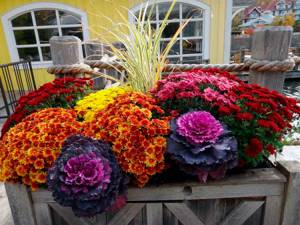
Using chrysanthemums in garden design
When planning planting chrysanthemums in the garden, it is necessary to take into account the height and width of the bush in order to choose a suitable place for them in the flower garden. It is better to plant tall varieties of chrysanthemum with tall plants, and low-growing ones - with low-growing species.
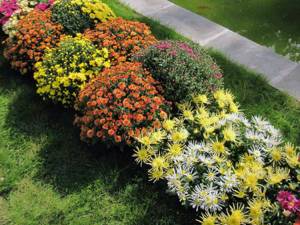
But combinations of varieties by height look no less interesting. Tall specimens should be planted in the background, while low varieties should be planted in the foreground of the flower bed.
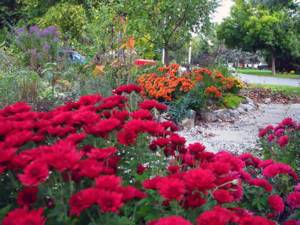
With the help of low chrysanthemums in the garden you can create beautiful borders. By planting chrysanthemums along the paths, you will delimit separate zones.

Chrysanthemums in the garden are combined in color, creating multi-colored or single-color decorative compositions. Red and snow-white chrysanthemums look very beautiful on a green lawn.
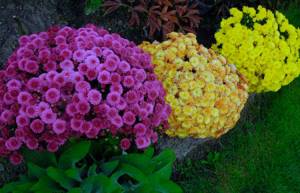
An interesting composition can be created by planting chrysanthemums of contrasting colors, for example, yellow and purple. Variegated flowers made up of colored chrysanthemums: red, yellow, pink and white will help make your autumn garden beautiful.
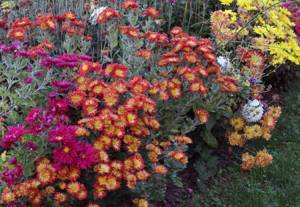
Single plantings of chrysanthemums in the garden also look very beautiful. A solo planting will look very impressive in the center of the lawn. Bush chrysanthemum is often used in mixborders, which create colorful horizontal or spherical color spots.

The highlight of the autumn garden can be a chrysanthemum, which is grown in the form of a cascade.
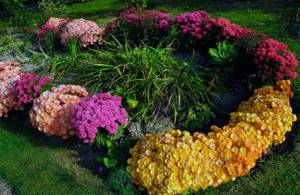
You can use a variety of chrysanthemum varieties in your autumn garden design. But the varieties with carved and variegated leaf blades look most beautiful. Plantings made from chrysanthemums alone look impressive. Chrysanthemums also go well with their closest relatives – asters.
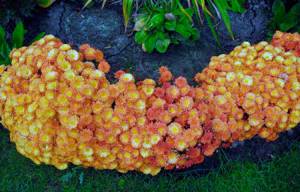
Many annual plants will be excellent neighbors for chrysanthemums - balsam, coleus, marigolds, zinnia, cosmos.

And if you want to create a long-flowering composition in your garden, plant plants such as calendula, snapdragons, and low asters next to charming chrysanthemums. Chrysanthemums in garden design look advantageous next to evergreen conifers or with cereals, enlivening their restraint and severity.
One of the most common plants of the Asteraceae variety is the chrysanthemum. The use of these flowers in landscape design is the best thing you can think of to decorate a garden plot.

The variety of colors and shapes of chrysanthemums allows you to create a unique look for the site
Useful tips
In order to grow beautiful and lush chrysanthemums in the garden, do not skimp on planting material and buy only high-quality rooted cuttings. Plant chrysanthemums in the spring, choose strong, healthy plants sold with a clod of soil.

different varieties of chrysanthemums in a garden bed
It is recommended to first germinate annual varieties propagated by seeds into seedlings at home and plant them in open ground only after the threat of return of frost has completely passed and smooth, warm weather has established itself outside.
If you want to enjoy the sight of beautiful chrysanthemums in your garden, give the plant due attention. Follow these tips for caring for chrysanthemums, and they will definitely delight you with lush, fragrant inflorescences.
Origin and merits of the flower
To obtain chrysanthemum, various large-flowered varieties from Japan and China were used. There are certain varieties that were created by crossing chrysanthemums from China and India. They have smaller flowers and richer shades.
Every person who grows flowers can easily decorate their garden with these bright garden daisies (as chrysanthemums are popularly called). This is facilitated by the main advantages of the plant.
- Long periods of flowering with lush buds, occurring from spring to late autumn.
- Versatility of use. Some gardeners plant this flower along the border to create beautiful borders for the site, or complement it with evergreen shrubs and trees. Colorful hues will fill your garden with vibrant hues that will attract the attention of others.
Color classification
There are certain systems by which individual varieties are distinguished.
- In the Chinese system there are about 10 different species, which are classified according to flowering time and bud size.
- The French and German systems have the same criteria.
- In the English system there is an additional parameter that determines whether the plant can survive frost or not.
- In the American system, there are both wintering and heat-loving varieties.
You can systematize chrysanthemums according to the following parameters:
- plants bloom for 1 year or many years - here you should also consider the parameter whether the flowers overwinter in open areas or greenhouses;
- by flowering time - spring, summer or autumn;
- according to the appearance of the bush - shrubby or proportional;
- by bud size - large, medium and small;
- the appearance of the inflorescence is with a double, smooth or semi-double coating.
Chrysanthemums: care and propagation (video)
Types of chrysanthemums are determined by several characteristics, which do not always make it clear what the plants or their inflorescences look like:
- According to their ability to winter, annuals and perennials are distinguished (variations - wintering and non-wintering, wintering in open ground or greenhouses);
- according to the timing of flowering - early, middle and late (option - spring, summer, autumn);
- according to the structure and size of the bush - bush and herbaceous, large, medium and mini;
- according to the size of the inflorescences - large-flowered, medium-flowered and small-flowered (the second name for small-flowered chrysanthemums is Korean);
- by type of inflorescence – double, simple, semi-double.

In addition, chrysanthemums are divided into such subspecies as keeled, field (sowing) and crown.
Most gardeners can grow this crop. Caring for flowers is quite easy, and with special care they will delight the eye with the brightness of their colors all summer and autumn, right up to serious frosts.
Application in landscape design
If you decide to plant low-growing chrysanthemum bushes in your landscape design, then it is better to make colorful living hedges or flower arrangements out of them.
In the summer, when other plants in the garden are actively blooming, the spherical chamomile will compact the area and create a more interesting composition. It will seem that your garden is strewn with flowers. In the fall, garden chamomile will produce colorful hues that provide the perfect contrast against the yellow leaves. Chrysanthemum in garden design is a universal plant that will make your garden unique at any time of the year.
Combination and winning compositions
Chrysanthemums with an average growth rate will look advantageous next to the following flowers in the flowerbed: lily, cosmos, balsam. If you have a lawn spreading across your yard, then give preference to red or white chrysanthemums - they will look amazing.
If you want a contrasting composition, plant purple, yellow or white, pink and red flowers nearby. For garden design, you can use any variety, but chrysanthemums with a carved or variegated plate are best suited. These flowers will go perfectly with asters.
Pursuing the goal of creating a long-lasting composition, pay attention to cold-resistant plants and plant the following flowers next to the chrysanthemum:
- calendula;
- Snapdragon.
Chrysanthemums with cereals or conifers will look great in landscape design - this way you can emphasize their restraint and severity.
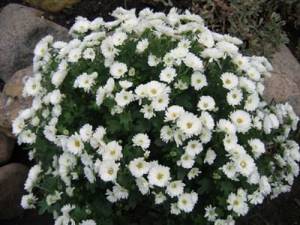
Compositions in the flower garden
To create a flower arrangement in the front garden or flower garden, you can use plants of different heights and colors. There are many schemes with plans for planting various varieties to create a ridge or an unusual flower bed.
Tall hybrids are usually planted in the background, medium-sized ones in the middle, and dwarf species in the foreground. The combination of different colors can be very diverse. Snow-white bush forms go well with red, pink, green, orange single-headed chrysanthemums.
Growing and planting
Chrysanthemums in landscape design must be planted correctly and also provided with high-quality care. Not only the dimensions of the bush depend on this, but also the color saturation. It is better to grow this type of plant in places where there is little protection from the sun. It is provided by small shrubs and climbing plants. If a flower screen is used, it must be periodically thinned out so that the chrysanthemum receives a small amount of sun.
These representatives of the Astrov family are not picky about soil. They can be planted both in loamy soils and chernozems. The main rule is to constantly loosen the soil. The more air gets to the roots, the greater the chance that the plant will be healthy. The most beautiful flower beds are obtained if the chrysanthemum is planted in loamy soil with a low alkaline balance. Humus and manure should be abandoned, because these fertilizers can burn the root system of a fragile flower, and the flowerbed will be ugly. The best fertilizer for the Astrov family is considered to be the remains of plants that are already at the stage of decay. Vermicompost needs to be added regularly for proper formation of the bush. 3-4 hours before planting, special complex substances created for the formation of chrysanthemums are added to the soil.
Drop off time
Chrysanthemums are planted in early spring. You need to take into account the weather conditions of your region. For the plant to take root, the soil must warm up to a depth of 20 cm to a temperature of 10-15 °C. Determining the temperature will not take much time. It is enough to remove a layer of soil by 20 cm and measure the temperature inside the flowerbed. If it is the same as in the upper layers of the soil, then planting can already be done.
Beautiful flower beds are obtained if you plant seedlings in cloudy weather or rain. The sun's rays negatively affect soil fertility. Planting is carried out in trenches, the depth of which is at least 18 cm. All trenches must first be treated with the growth stimulator “Kornevin” (20 g per 10 liters of water) and after the solution has been absorbed, planting can begin.
Different planting patterns
Depending on what types of chrysanthemum you choose, the planting pattern will also depend.
- If there are low-growing varieties that will serve as a border, then the distance between the trenches and rows should be 35 cm.
- Bush-like varieties are planted at a distance of 40 cm.
- Large, tall bushes - at a distance of 50 cm.
After a few days, the seedlings need to be watered and the growing point should be pinched. These actions will allow the plant to gain strength for active growth. After this, the flowerbed is covered with lutrasil. This material allows you to protect young bushes from frost, but it allows the air necessary for flowers to pass through. It can be removed when small leaves appear on the plant.
Chrysanthemum transplantation should be carried out in April, after the end of frost, with an interval of 3-4 years, when the buds on the bushes have not yet formed.

Nitrate - nitrogen fertilizer
Chrysanthemum in a flower garden
Chrysanthemum is not a plant for lazy people. It needs to be watered, fed and preferably shaped, and in addition, carefully choose a place for it, often divide it or renew it with cuttings.
Despite everything, in the Russian garden it is one of the most recognized crops. Shoots of Korean garden chrysanthemum begin to grow at temperatures of 2–6°C. In spring, it emerges from the ground early - long before hostas, peonies, astilbes and other soloists of our flower beds decide to do so. Its attractive, carved foliage decorates the flower garden all summer, and its design-friendly, slightly bluish hue makes it a perfect addition to any color combination. A lush, well-formed bush has a clear dome-shaped shape; it reaches the required volume already in the first year after planting - a rare quality for structural plants. However, many varieties with spreading bushes, especially if they are not pinched, are also suitable for the role of “fillers”, highlighting the beauty of perennials with a pronounced geometric shape.
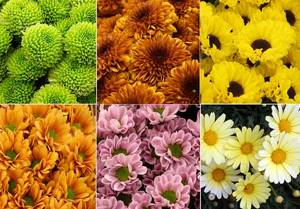
During flowering, Korean chrysanthemums tolerate frosts down to –10°C, and after that they can thaw and continue to bloom. Perhaps in countries with a mild climate, all these qualities are not a gift of fate, which is why chrysanthemum is not held in high esteem by European designers. But here everything is different: in the Central region, the threat of frost passes only on June 10 and reappears on September 15, which means frost resistance is a trump card for any garden plant. If it is important for you to have a beautiful garden all year round, consider Korean chrysanthemums, which remain attractive in harsh weather conditions.
Raised flower beds (due to good drainage) create ideal conditions for the growth of chrysanthemums. It is undesirable to make their surface convex, as is often done with regularly shaped flower beds. The most successful option is a leveled surface, limited by a concrete or stone border, slightly rising above the surface of the soil in the flower garden. This will allow in June-July, especially in hot weather, to provide the plants with increased watering (which chrysanthemums need), and in the fall, when excessive humidity, on the contrary, is harmful, the water in the raised flower bed will not stagnate.
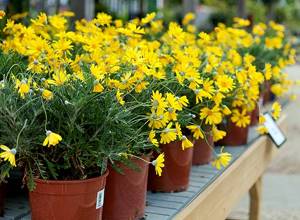
You can use chrysanthemums in regular compositions, in flower beds of simple geometric shapes - round, oval, rectangular. Since regular flower beds are usually placed in ceremonial places, they should always be decorative. A combination of chrysanthemums with spring-flowering bulbs will be successful (after all, they, like tulips of some groups, are replanted approximately once every 3-4 years). Among the annuals, good neighbors for chrysanthemums are tagetes, nasturtiums, cineraria, and kochia. In well-drained areas, chrysanthemums can be planted in mixborders along with ornamental grasses, sedum, sedum, daylilies, heuchera, stachys, sage, hyssop, eryngium. Having grown by autumn, tall varieties of chrysanthemums will cover plantings of delphiniums and lilies that are unattractive at this time. Low-growing varieties of chrysanthemums, well-leafed in the lower part, are suitable not only for regular flower beds and mixborders, but also for border plantings, and especially for containers.

Care measures
You need to care for chrysanthemums according to all the rules. If you violate even one condition, there is a risk of losing most of the bushes, and the flowerbed will no longer seem beautiful. The plant needs to be provided with adequate watering, which is carried out at the root. Do not allow water to get on the leaves or trunk of the bush. This increases the risk of disease. Water should be used from rainwater, filtered or settled . To do this, fill the container with the required amount of water and leave it for several days in a cool, dark place. Watering should be done at intervals of 2 days. For tall plants, pour 2.5 liters of water, and for short plants - 1 liter. The next day after watering, using a rake or hoe, you need to loosen the top layer of soil so that air can pass to the roots.
Fertilizers are applied monthly. A month after planting, you need to feed the bushes with saltpeter (30 g per 5 liters of water). After another 2 weeks, use a solution of rotted plants and potassium (40 g per 8 liters of water). After another 3 weeks, a solution of phosphorus and potassium is added (20 g per 10 liters of water). For the 4th month, you can feed chrysanthemums with a tincture of sage, phosphorus and bird droppings (40 g per 20 liters of water). For 1 sq. m of plot use 5 liters of fertilizer. All subsequent fertilizing should consist of the use of complex fertilizers, which are purchased in special flower shops. Before winter, it is better to reduce the amount of nitrogen substances, otherwise the flowers will not be able to prepare and will die.











